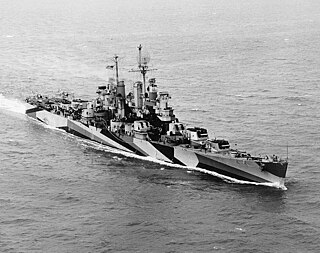Related Research Articles
Three ships of the United States Navy have borne the name Brooklyn, after the New York City borough of Brooklyn.

USS Brooklyn (CL-40) was a light cruiser, the lead ship of her class of nine, and the third United States Navy ship to bear its name. Commissioned in 1937, she served in the Atlantic during World War II, as a convoy escort and as fire support for amphibious landings.
Two ships of the United States Navy have borne the name Boise, after Boise, Idaho.

USS Duluth (CL-87) was a United States Navy Cleveland-class light cruiser.
USS Amsterdam may refer to either of two U.S. Navy ships named for Amsterdam, New York:
Four ships of the United States Navy have been named Astoria, after the town of Astoria, Oregon.
Five United States Navy ships have borne the name Atlanta, after the city of Atlanta, Georgia:
Three ships of the United States Navy have been named Birmingham, after the city of Birmingham, Alabama.
Four ships of the United States Navy have been named Chattanooga, after the city of Chattanooga, Tennessee.
USS New Haven may refer to:

USS Fargo (CL-106), named after the city of Fargo, North Dakota, was the lead ship of her class of light cruisers of the United States Navy, most of which were canceled due to the end of World War II.
Five ships of the United States Navy have been named USS Cincinnati, after the city of Cincinnati, Ohio.
Four ships of the United States Navy have been named USS Cambridge, after the various US places named Cambridge.

The second USS Fresno (CL-121) was a United States Navy Juneau-class light cruiser launched on 5 March 1946 by Federal Shipbuilding and Dry Dock Company of Kearny, New Jersey, sponsored by Mrs. Ruth R. Martin; and commissioned on 27 November 1946, with Captain Elliott Bowman Strauss in command. She was reclassified CLAA-121 on 18 March 1949.

The second USS Juneau (CL-119) was the lead ship of the United States Navy Juneau-class cruisers laid down by the Federal Shipbuilding and Drydock Company in Kearny, New Jersey, on 15 September 1944; launched on 15 July 1945; sponsored by Mrs. B. L. Bartlett; and commissioned 15 February 1946, Captain Rufus E. Rose in command.

USS Little Rock (CL-92/CLG-4/CG-4) is a Cleveland-class light cruiser and one of 27 completed for the United States Navy during or shortly after World War II. She is one of six to be converted to guided missile cruisers and the first US Navy ship to be named for Little Rock, Arkansas. Commissioned in mid-1945, she was completed too late to see combat duty during World War II and was retired post-war, becoming part of the Atlantic Reserve Fleet in 1949.

The second USS San Diego (CL-53) was an Atlanta-class light cruiser of the United States Navy, commissioned just after the US entry into World War II, and active throughout the Pacific theater. Armed with 16 5 in (127 mm)/38 cal DP anti-aircraft guns and 16 Bofors 40 mm AA guns, the Atlanta-class cruisers had one of the heaviest anti-aircraft broadsides of any warship of World War II.
USS Growler (1812) was a 53-ton wooden schooner of 5 guns that served in the War of 1812, changing hands three times.

USS Pawnee (AT-74/ATF-74) was a Navajo-class fleet tug in the United States Navy.

The Juneau-class cruisers were United States Navy light cruisers which were modified version of the Atlanta-class cruiser design. The ships had the same dual-purpose main armament as USS Oakland with a much heavier secondary antiaircraft battery, while the anti-submarine depth charge tracks and torpedo tubes were removed along with a redesigned superstructure to reduce weight and increase stability. Three ships were ordered and built, all completed shortly after World War II, but only Juneau remained active long enough to see action during the Korean War.
References
- This article incorporates text from the public domain Dictionary of American Naval Fighting Ships .The entry can be found here.
- This article includes information collected from the Naval Vessel Register , which, as a U.S. government publication, is in the public domain.The entry can be found here.